
When I last looked at Dell's largest XPS laptop, it offered a traditional design centered on a 17-inch display powered by a 13th-gen Intel processor and RTX graphics. With this year's update, Dell has introduced a radical new design while slightly shrinking the display and making the requisite update to Intel's current Core Ultra CPUs.
The Dell XPS 16 9640 features a 16.3-inch display that feels every bit as spacious as the previous 17-inch XPS 17 9730's while saving you a bit of travel weight. A bigger departure is the minimalistic design that features a borderless touchpad, a nearly flat keyboard with little to no spacing between the keys and a Function row that consists not of physical keys but touch-sensitive icons.
The invisible touchpad is a cool trick, and thanks to its accurate and lively haptics, it's as fun to use as it is to look at. I'm less sold on the touch-sensitive yet haptic-less Function row, but I must say the XPS 16 9640's overall look is indeed unique and rather stunning. And I was pleased to see that Dell has an OLED display option, which wasn't available for the XPS 17 9730. Add in strong overall performance and surprisingly robust battery life, and the Dell XPS 16 9640 checks a lot of boxes for creatives who are looking for a big-screen laptop and are willing to spend a pretty penny to get it.
| Price as reviewed | $3,399 |
|---|---|
| Display size/resolution | 16.3-inch 3,840x2,400 90Hz OLED |
| CPU | Intel Core Ultra 7 155H |
| Memory | 32GB DDR5 SDRAM |
| Graphics | Nvidia GeForce RTX 4070 |
| Storage | 1TB SSD |
| Ports | 2x Thunderbolt 4 USB-C, USB-A 3.2 Gen 2, microSD card, combo audio |
| Networking | Wi-Fi 7, Bluetooth 5.4 |
| Operating system | Windows 11 Home 23H2 |
| Weight | 5 pounds (2.3 kg) |
Our Dell XPS 16 9640 test system includes significant upgrades that nearly double its price from the baseline $1,899 to a lofty $3,399. The base model features an Intel Core Ultra 7 155H processor, 16GB of RAM, Intel Arc graphics, a 512GB SSD and a 1,920x1,200-pixel IPS display. Our test model offers 32GB of RAM, RTX 4070 graphics, a 1TB SSD and a 4K OLED display. For the case, you can choose between a creamy silver that Dell calls platinum or a matte black the company dubs graphite.
There are a few other customization options not included on our test system: a Core Ultra 9 185H CPU, RTX 4050 and 4060 GPUs, and up to a 4TB SSD. You can also opt for vPro, which delivers remote-management features for IT departments in charge of a fleet of XPS 16 machines.
The Dell XPS 16 9640 starts at £1,849 in the UK and AU$2,798 in Australia.
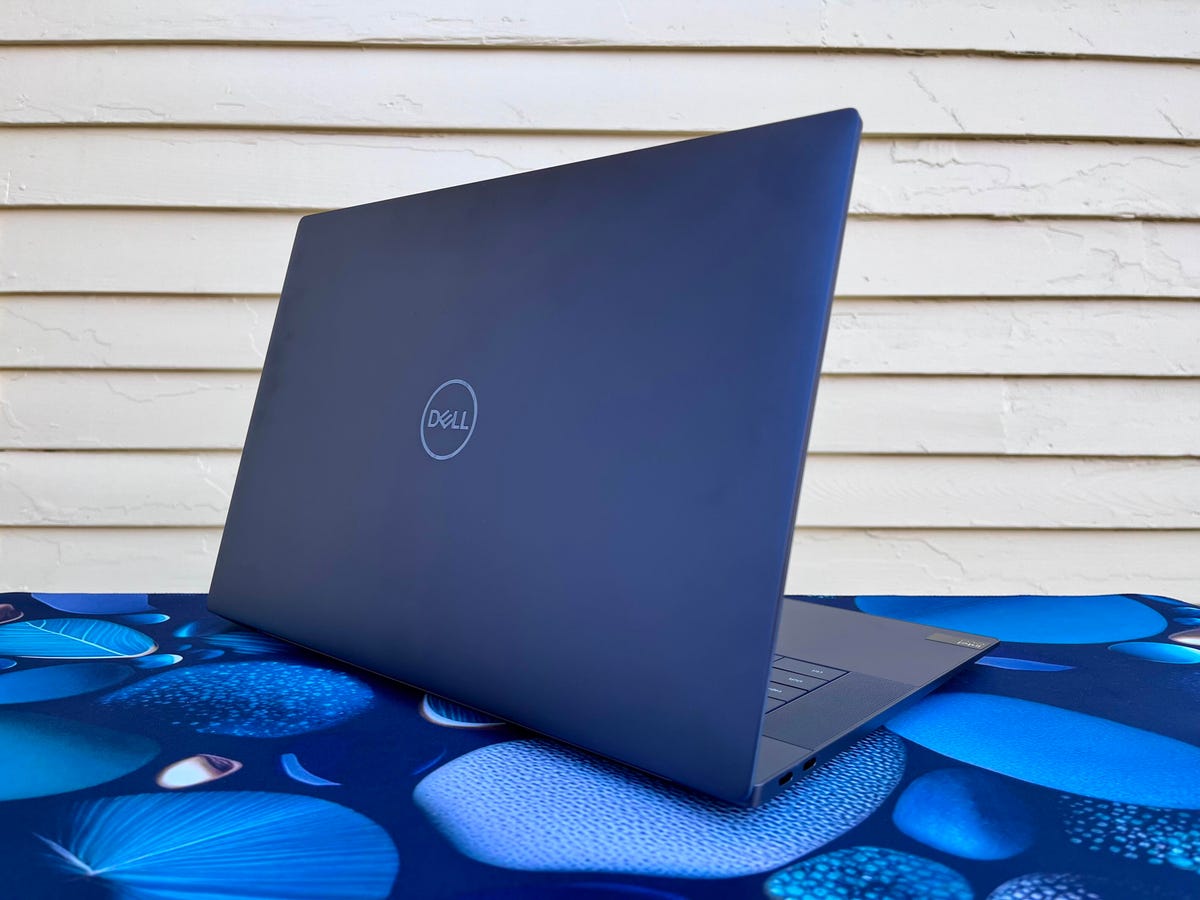 Matt Elliott/CNET
Matt Elliott/CNETThe XPS 16 9640's performance was on par with that of other laptops we've tested with the Core Ultra 7 155H processor and RTX graphics. It's a versatile performer, offering strong application performance as well as graphics performance. It posted solid framerates on our 3D gaming tests, but its RTX 4070 is set to run at a maximum of 70 watts, so it's not quite at gaming laptop levels with a full-throttle RTX 4070 such as the Alienware m16 R2. With minimal venting and a compact chassis, the XPS 16 9640 does produce a fair amount of fan noise under heavy load, but it's relatively quiet during normal operation.
Perhaps the most impressive result is its showing on our battery test. A 4K OLED display might be crisp and beautiful, but that combination of a high pixel count and OLED technology usually has an adverse effect on a laptop's runtime. Dell outfits the XPS 16 9640 with a robust six-cell, 99.5-watt-hour battery, and it lasted more than 11.5 hours on our online streaming battery drain test, which is a positive result for any laptop and an outstanding outcome for one with a large 4K OLED display.
The most striking part of the XPS 16 9640's design is its apparent lack of a touchpad. I can assure you, it's there. It just lacks borders and blends seamlessly into the wide wrist rest. The invisible touchpad sits centered below the display and is large enough that I didn't find myself clicking on an area outside of its haptics. The haptic feedback is excellent and customizable, so you can dial in how lively you'd like the click response to be.
The touchpad lacks borders, and the keyboard lacks space between the keys. The latticeless design looks different than the typical island-style keyboard that provides some separation between the keys, but I found typing on the XPS 16 9640's keys to be no different than using a more traditional keyboard design. The keys offer shallow travel and a slightly mushy response. If I could change one thing about the keyboard, it would be firmer feedback with each key press and not the key spacing.
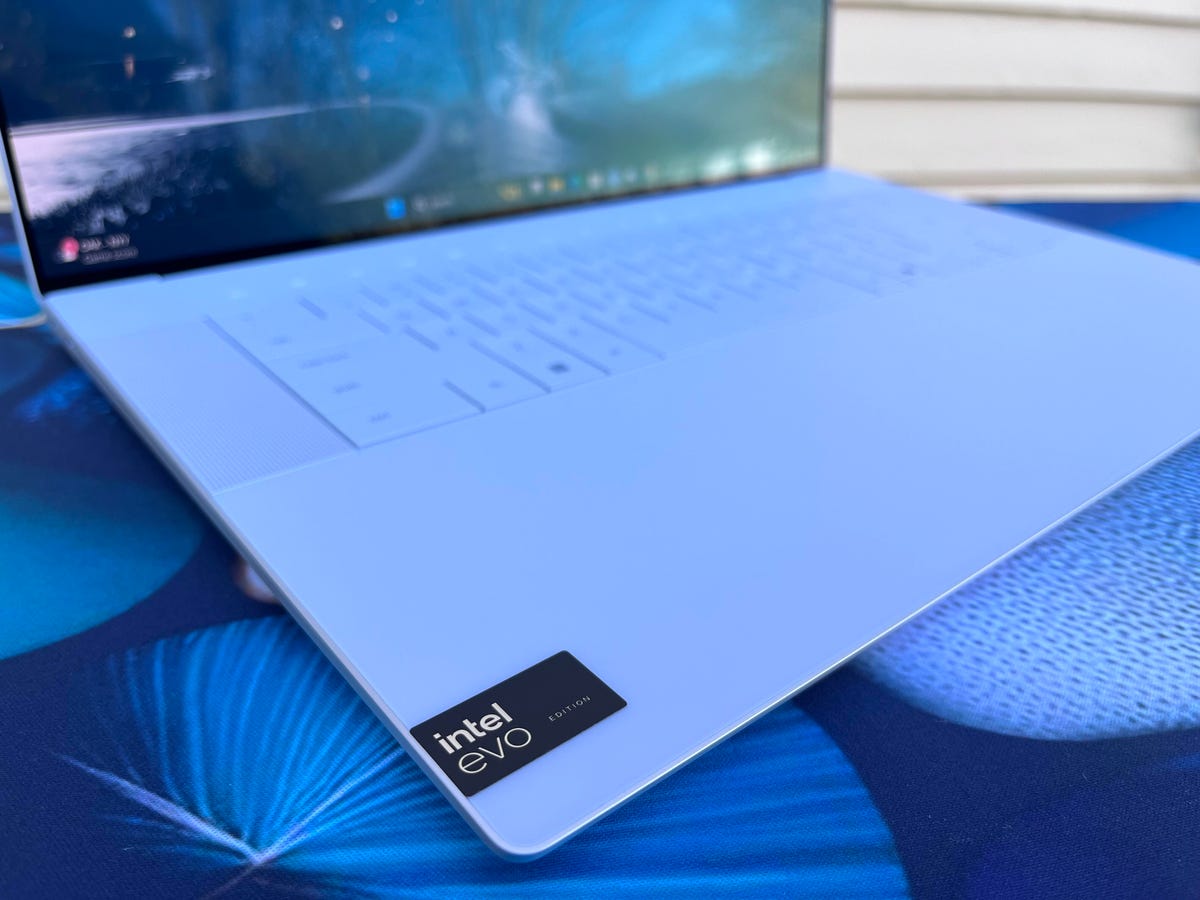 Matt Elliott/CNET
Matt Elliott/CNETThe third component of the laptop's streamlined design is eschewing a traditional row of Function keys for a strip of touch-sensitive icons. As I discussed in my previous review of the Dell XPS 14 9440, I'm not a fan. I didn't enjoy my MacBook Touch Bar years, and I don't like this row of icons that lack haptic feedback and feature always-on LEDs. I get that physical Function keys would detract from the overall design; it's nice that the icons can flip between media and function keys. But the loss of physical keys I can feel myself pressing is not a trade-off I'm willing to make for the sake of design.
Dell's focus on keeping the look of the XPS 16 9640 as minimal as possible results in neither a notch nor a cut-out area on the laptop's front edge that would aid in raising the lid. This arrangement made opening the XPS 14 9440 laptop needlessly difficult, but I didn't have nearly as much trouble on this larger model despite each sharing the same design. It's not quite as easy as other laptops that give you a way to get a better grip on the front edge of the display to lift it, but I was still more successful than not in opening the XPS 16 9640 with one finger.
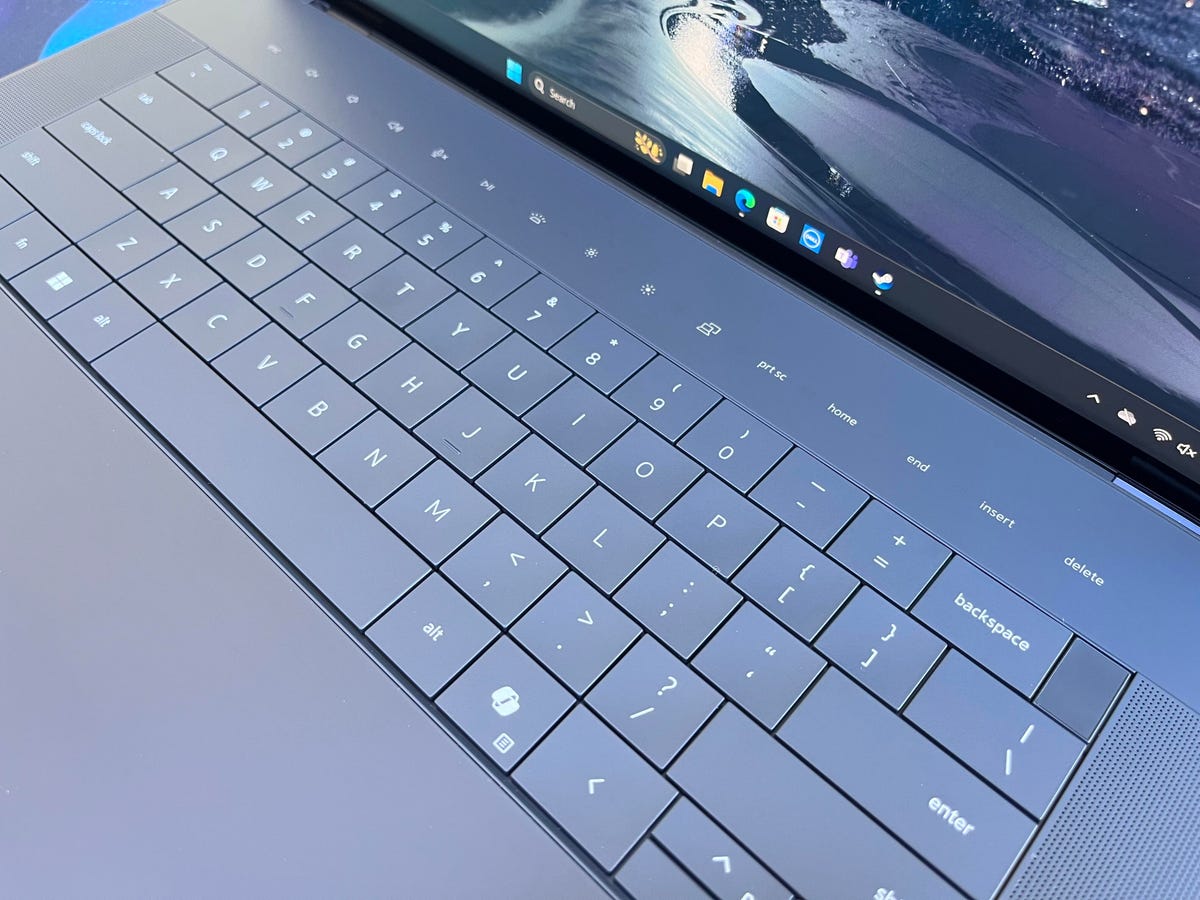 Matt Elliott/CNET
Matt Elliott/CNETThe above design elements give the XPS 16 9640 a unique and minimalistic design, but it's not just surface looks -- this is a solidly put-together laptop. The machined aluminum chassis feels rigid and doesn't creak or flex. The display bezels are incredibly thin to keep it about as compact as a 16-inch laptop can be. It weighs 5 pounds, which is appreciably lighter than the 5.5-pound XPS 17 9730 but negligibly heavier than other 16-inch models, including the 4.8-pound Dell Inspiron 16 Plus 7630 and 4.7-pound Apple MacBook Pro 16. Lighter still are the Acer Swift X 16 and HP Spectre x360 16, with each weighing just 4.3 pounds.
We received the display upgrade to a 4K OLED panel. It adds $300 to the bill and provides a crisper picture and superior contrast. In testing, it offered good color coverage with 100% sRGB, 89% AdobeRGB and 99% P3. It hit a peak brightness of 382 nits, which, with its stellar contrast, is ample for nearly every environment, with the exception of working outside in direct sunlight. You can save $300 by stepping down to the RTX 4060. If choosing between the two equal options, I'd opt for the OLED powered by an RTX 4060 rather than the baseline IPS and an RTX 4070.
The OLED panel can operate at a refresh rate of 90Hz for smoother movement or at 60Hz to help extend battery life. Unfortunately, the refresh rate isn't dynamic, so you'll need to dig into settings to change it if you go from, say, watching or editing video or gaming at 90Hz to unplugging and working on battery power and downshifting to 60Hz.
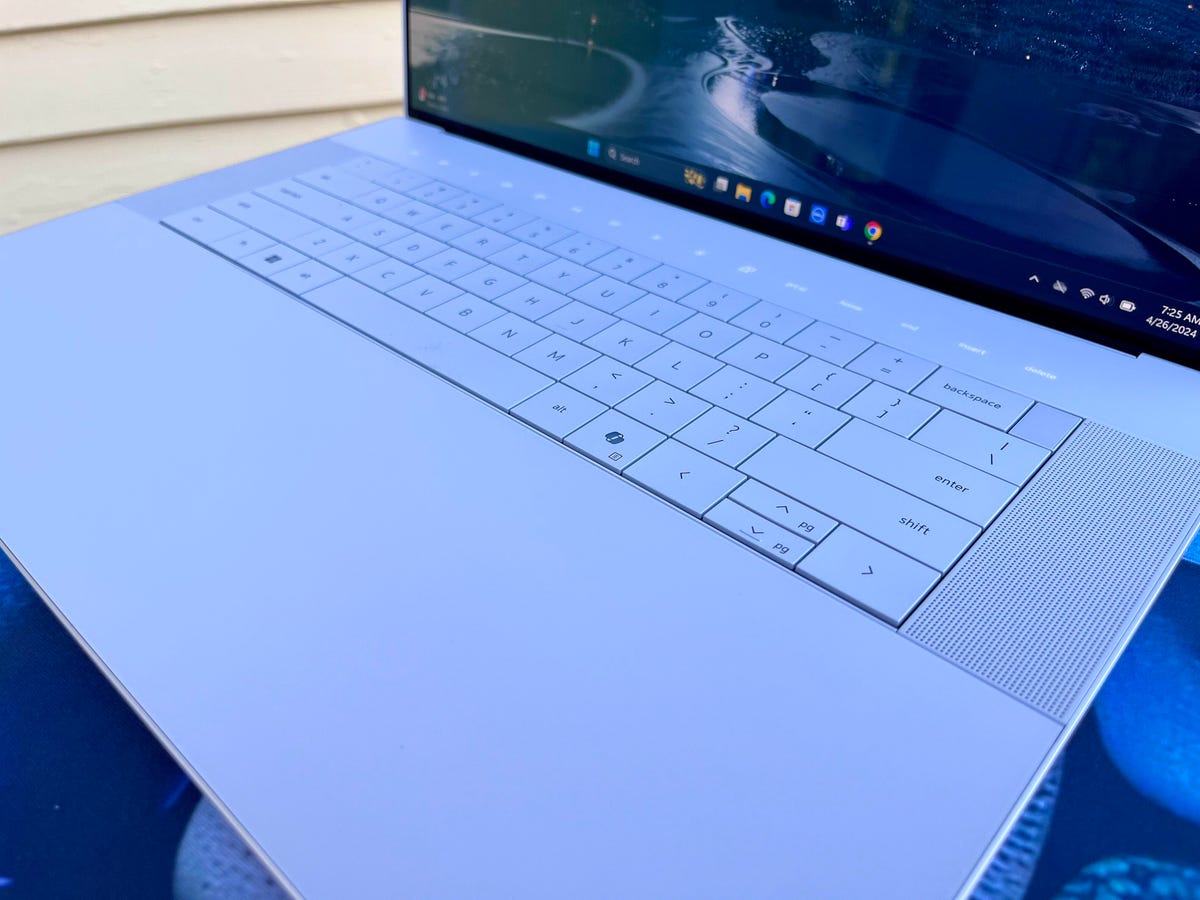 Matt Elliott/CNET
Matt Elliott/CNETAlong with strong visuals, the XPS 16 9630 boasts impressive audio output. This is one of the few laptops that had enough of a bass response that music playback was actually enjoyable. Granted, I experienced this joy while seated in a small room directly in front of the laptop, but at this very same desk in this very same room, I'm usually somewhere between underwhelmed to sorely disappointed by a laptop's audio. The XPS 16 9640 features a total of 10 watts of output by way of a pair of 3-watt main speakers and a pair of 2-watt tweeters. Most laptops offer only two 2-watt speakers.
Another upgrade the XPS 16 9640 received from the previous XPS 17 is a 1080p webcam. It's hard to give Dell kudos for this move since the 720p camera was already outdated on last year's XPS 17. The camera produces images nearly free of the graininess of a 720p camera, with accurate colors and skin tones. You'll appear clearly on video calls. And you can use the camera with Windows Hello for easy, secure logins via facial recognition. The power button also doubles as a fingerprint scanner if you'd prefer to go that biometric route.
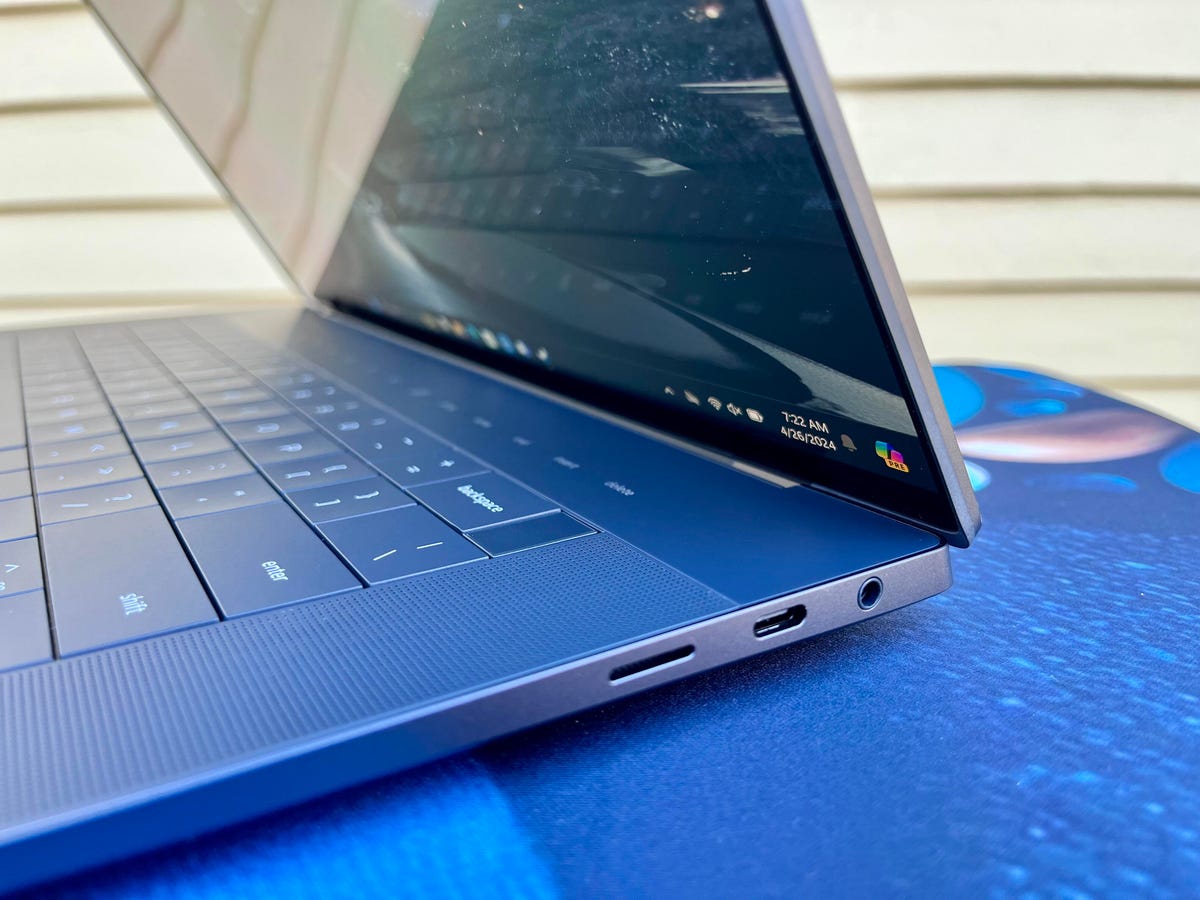 Matt Elliott/CNET
Matt Elliott/CNETPorts are minimal but should suffice for most users, with two Thunderbolt 4 ports and a USB-C 3.2 Gen 2 port along with a headphone jack and microSD card slot. The two biggest missing items are an HDMI output and a USB-A port, but Dell includes a dongle for each of those connections.
At $3,399, our XPS 16 9640 test system costs less than the $3,999 configuration of the mostly maxed-out MacBook Pro 16 we tested at the end of last year but is still at the high-end of the premium laptop class. It offers the design and performance that's befits its price, however, and Dell's numerous customization options mean you can likely land on a configuration that meets your needs and budget.
The review process for laptops, desktops, tablets and other computerlike devices consists of two parts: performance testing under controlled conditions in the CNET Labs and extensive hands-on use by our expert reviewers. This includes evaluating a device's aesthetics, ergonomics and features. A final review verdict is a combination of both objective and subjective judgments.
The list of benchmarking software we use changes over time as the devices we test evolve. The most important core tests we're currently running on every compatible computer include Primate Labs Geekbench 6, Cinebench R23, PCMark 10 and 3DMark Fire Strike Ultra.
A more detailed description of each benchmark and how we use it can be found on our How We Test Computers page.
Note: Longer bars indicate better performance
Note: Longer bars indicate better performance
Note: Longer bars indicate better performance
Note: Longer bars indicate better performance
Note: Longer bars indicate better performance
Note: Longer bars indicate better performance
Note: Longer bars indicate better performance
| Dell XPS 16 9640 | Microsoft Windows 11 Home; Intel Core 7 Ultra 155H; 16GB DDR5 7,467MHz RAM; 8GB Nvidia GeForce RTX 4070; 1TB SSD |
|---|---|
| Acer Swift X 16 | Microsoft Windows 11 Home; AMD Ryzen 9 7940HS; 16GB DDR5 6,400MHz RAM; 6GB Nvidia GeForce RTX 4050; 1TB SSD |
| Alienware m16 R2 | Microsoft Windows 11 Home; Intel Core 7 Ultra 155H; 16GB DDR5 5,600MHz RAM; 8GB Nvidia GeForce RTX 4070; 1TB SSD |
| Dell Inspiron 16 Plus 7630 | Microsoft Windows 11 Home; Intel Core i7-13700H; 16GB DDR5 4,800MHz RAM; 8GB Nvidia GeForce RTX 4060; 1TB SSD |
| HP Spectre x360 16 | Microsoft Windows 11 Pro; Intel Core Ultra 7 155H; 16GB DDR5 RAM; 6GB Nvidia GeForce RTX 4050; 1TB SSD |
| Apple MacBook Pro 16 (M3 Max, 2023) | Apple MacOS Sonoma 14.1; Apple M3 Max (16-core CPU, 20-core GPU); 48GB unified memory; 1TB SSD |